How To Draw A Porsche 918 Spyder
Porsche 918 Spyder
Introduction
The biggest automotive concern on the planet could hardly stay out of a hypercar sparring match on the world stage, and with the Porsche 918 Spyder, VAG emphasized its strongest points in the hybrid against LaFerrari and the McLaren P1.
With the engineering might (and budget) of Porsche behind it, and drawing upon the company's experience of racing hybrids in endurance racing, the 918 Spyder managed to undercut its rivals on price, while providing arguably the most complete road car package of the holy trinity.
Appropriately, 918 examples of the Spyder were promised, with Porsche digging deep into its motorsport knowledge to produce technology that provided world-beating performance, as well as reducing fuel consumption.
(OK, we're not going to convince you that the 918 Spyder's hybrid system was entirely geared at saving fuel, but official tests on the New European Driving Cycle, which includes urban, extra-urban and combined driving cycles, rated this hypercar at an impressive 85mpg and 79 g/km of CO2 emissions – actual results with 887hp at your disposal may vary…)
Design, Styling & Interior
With styling cues from Porsche's racing heritage – including top-exit exhaust pipes that improve the efficiency of heat dispersion from the mid-mounted 4.6-litre V8 (and that this writer thinks are one of the best car design elements to appear this side of the turn of the century) – and designed around aerodynamic efficiency and a carbon fibre monocoque chassis, which helps lower the centre of gravity and improve the overall rigidity of the car, the 918 has still somehow managed to emerge with a shape that is distinctly Porsche.
Look at a completely shaded silhouette image of this and a Boxster or Cayman side by side, with no other visual hints, and it would take a severely dedicated hypercar enthusiast to tell the pair apart – though of course you're on this site, which means (ideally) that's exactly what you are.
Step inside, and you find a cockpit that is better appointed than you might expect given the performance the 918 is capable of. The 918's interior is lavish, and while carbon fibre still makes an appearance, the remainder of the interior is stunningly trimmed.
Driver and passenger are separated by a centre console that rises from the floor a la the 918's predecessor – the Carrera GT – while a smaller, 310mm steering wheel debuted on the hypercar that has since been used on other high performance Porsches.
Looking for some wind in your hair? Look no further. The 918's party piece (well, one of them) is the lift-out roof panel hinted in its name, giving driver and passenger access to miles and miles of sky.
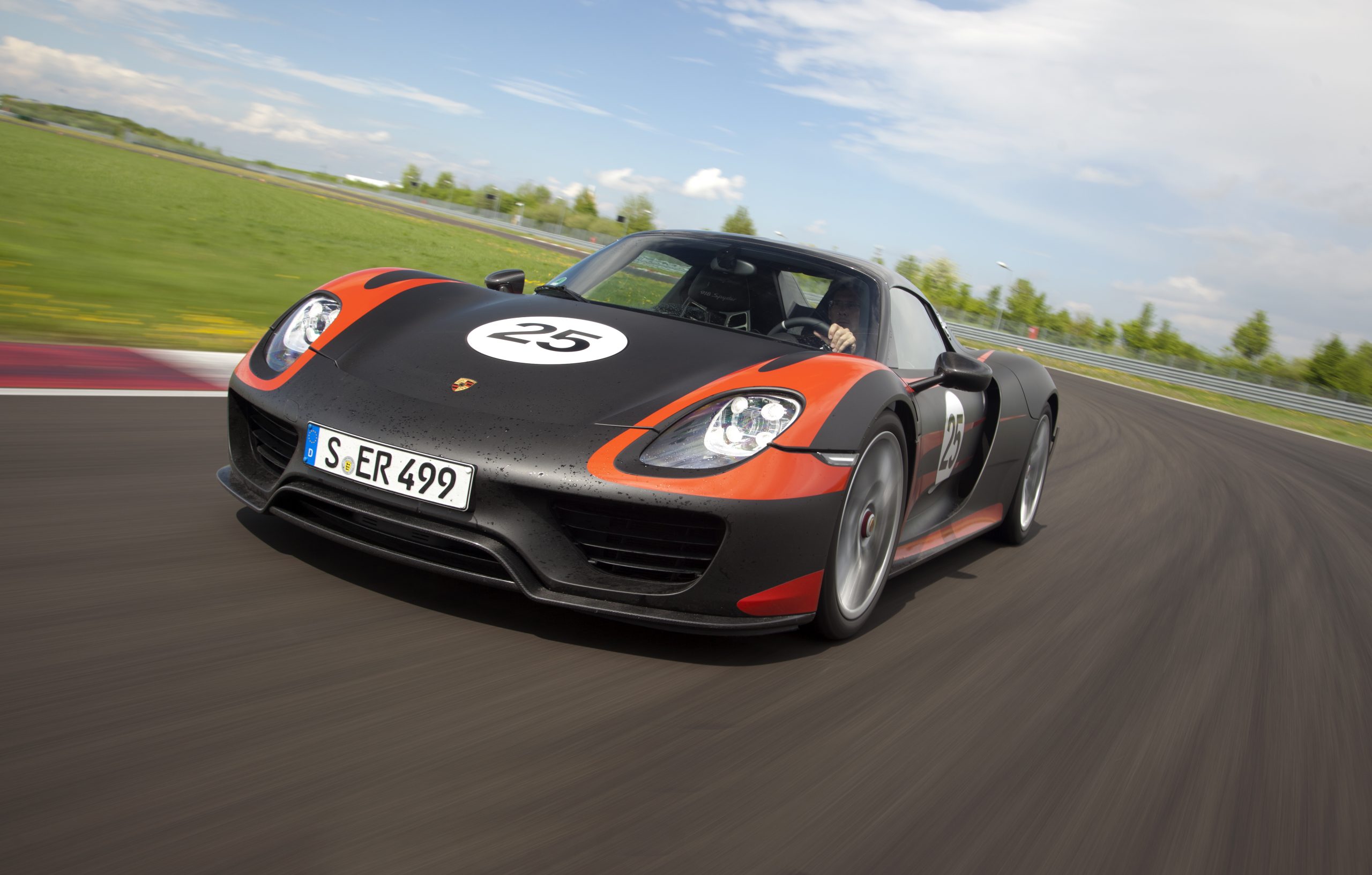
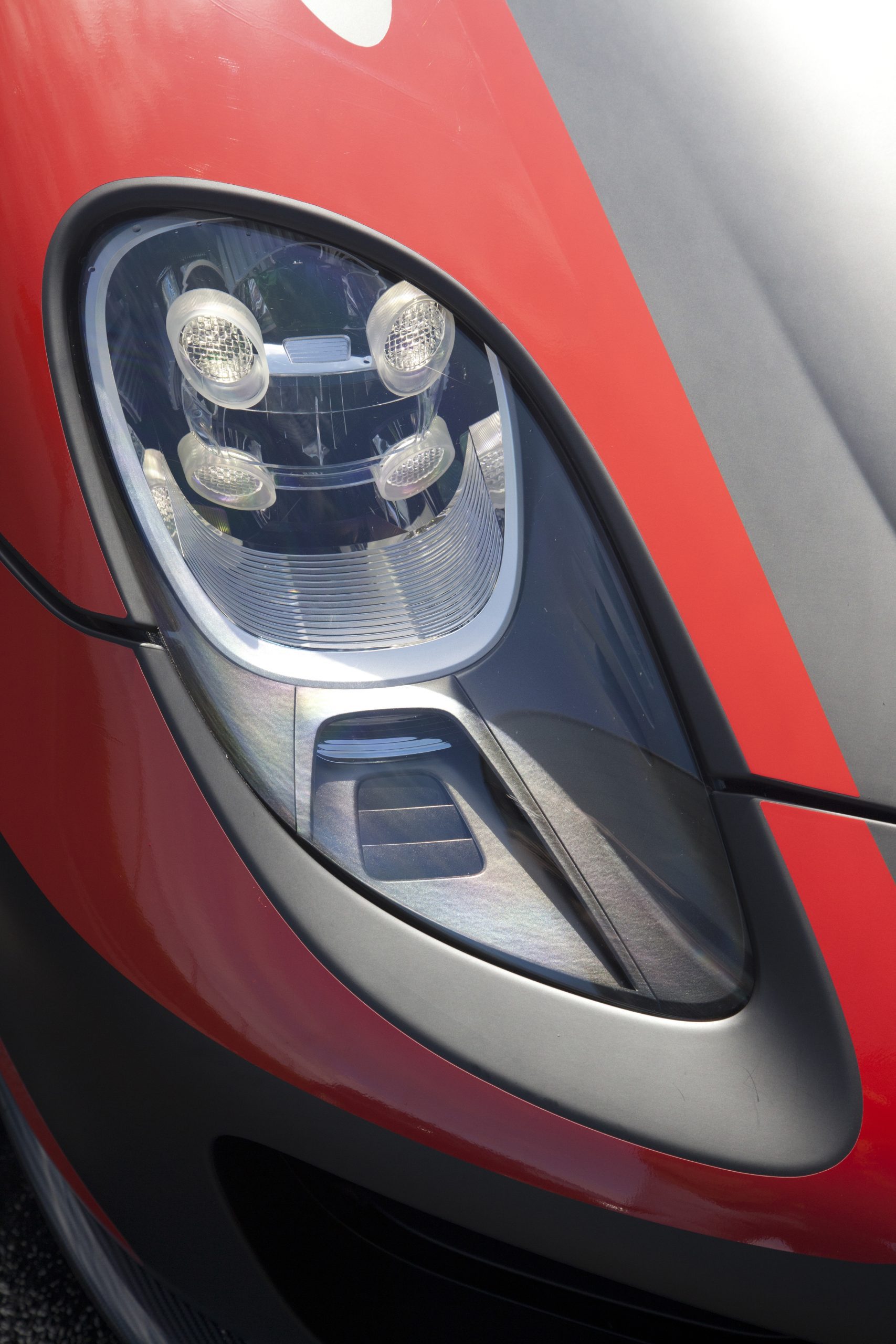
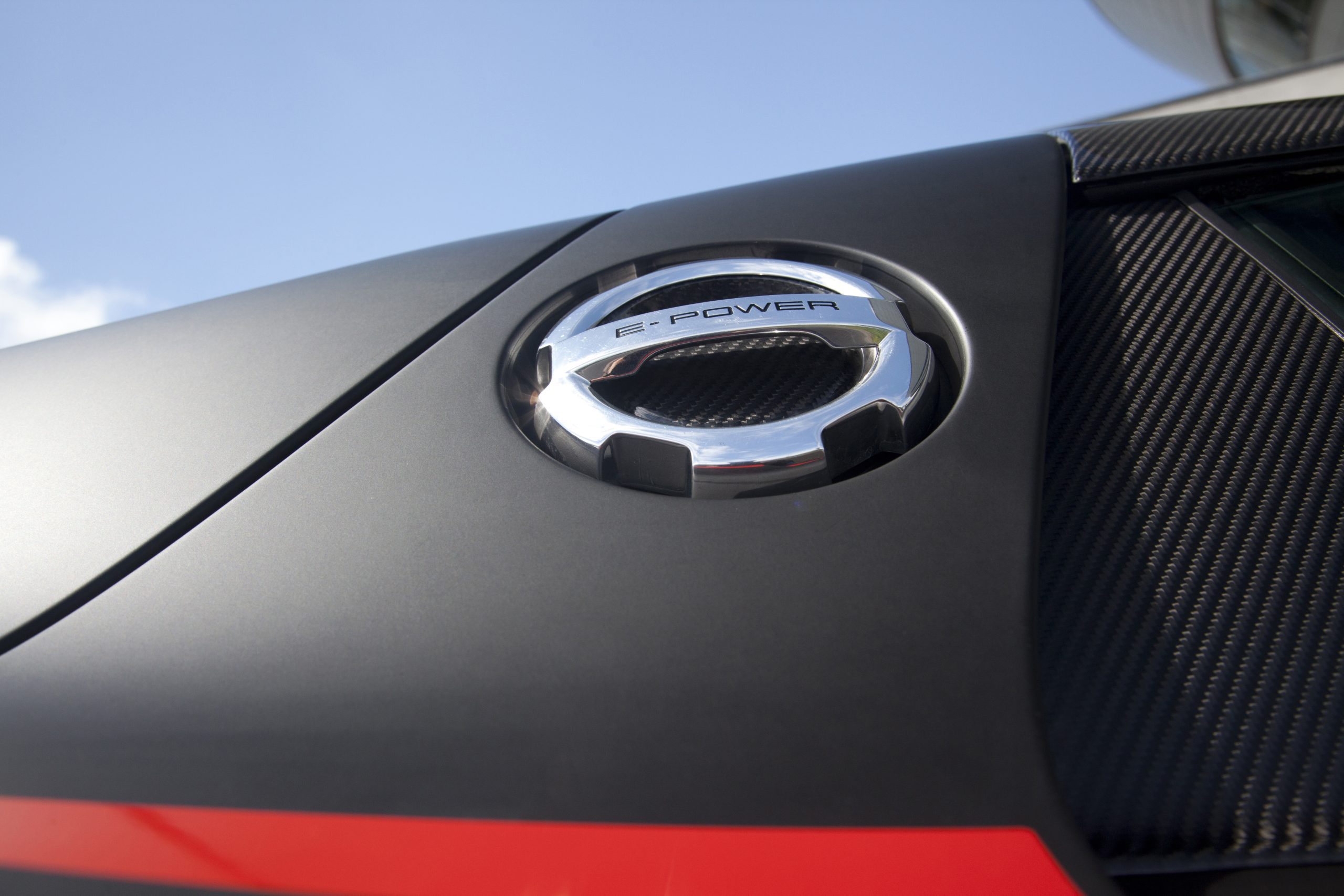
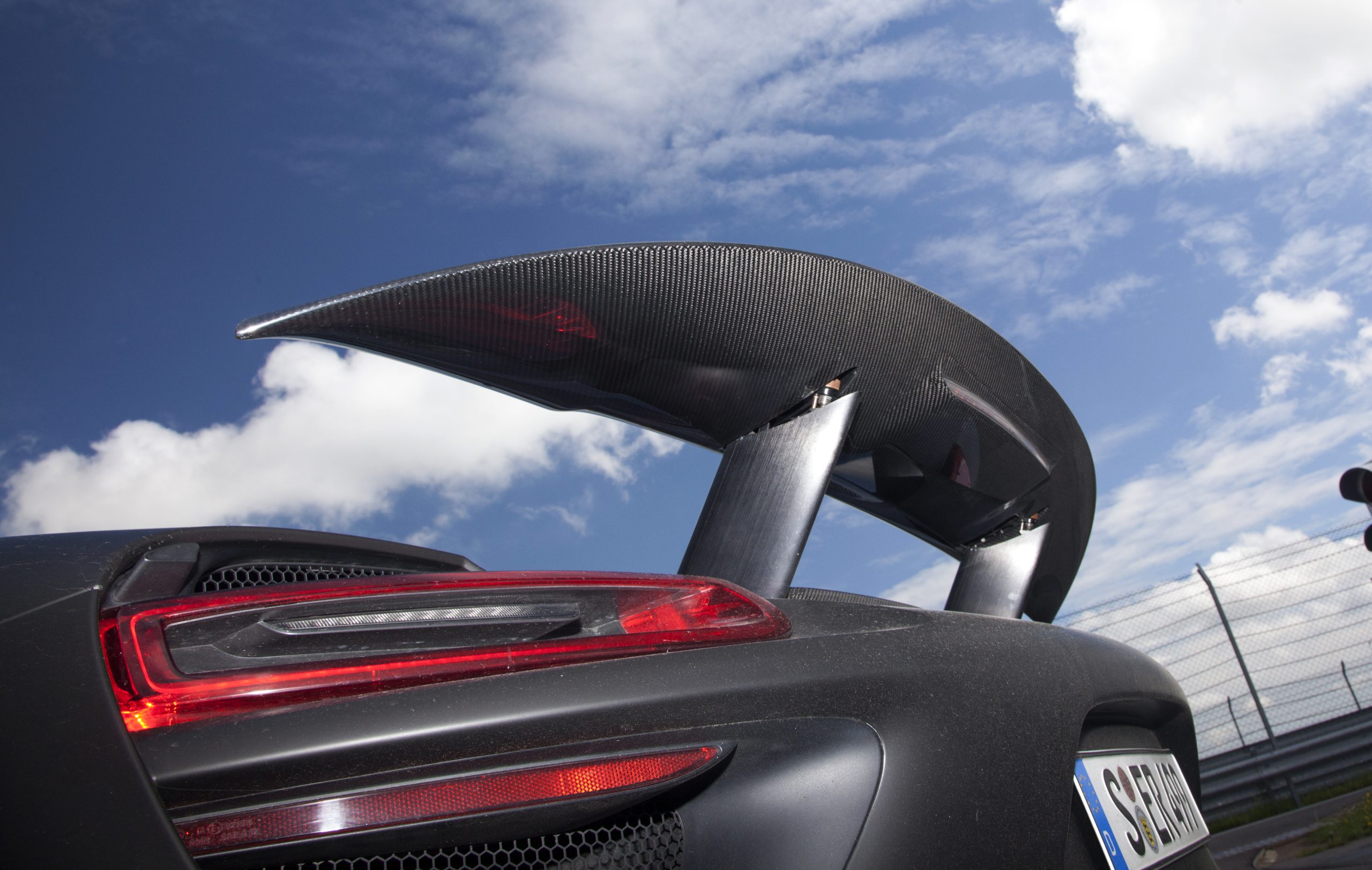
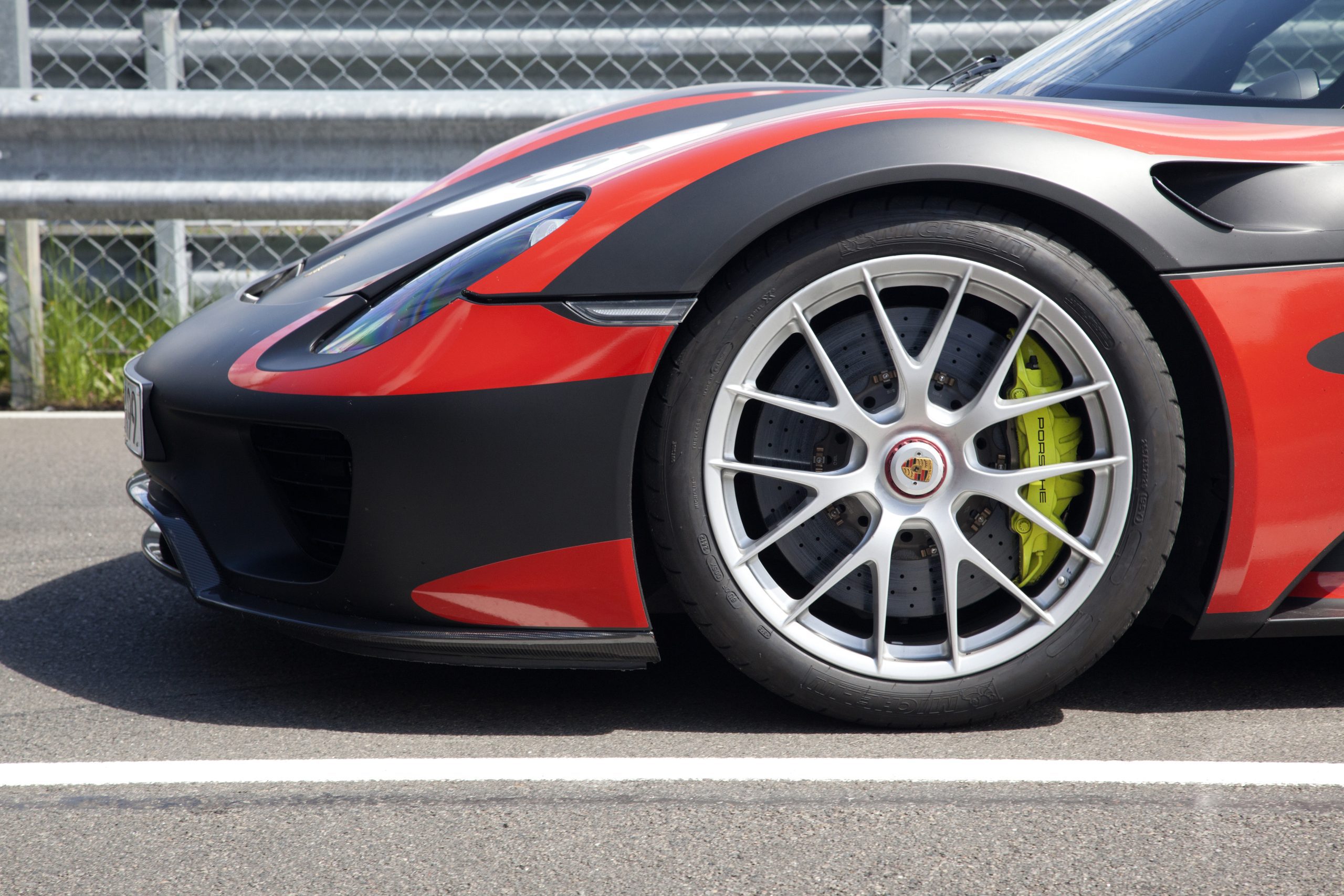
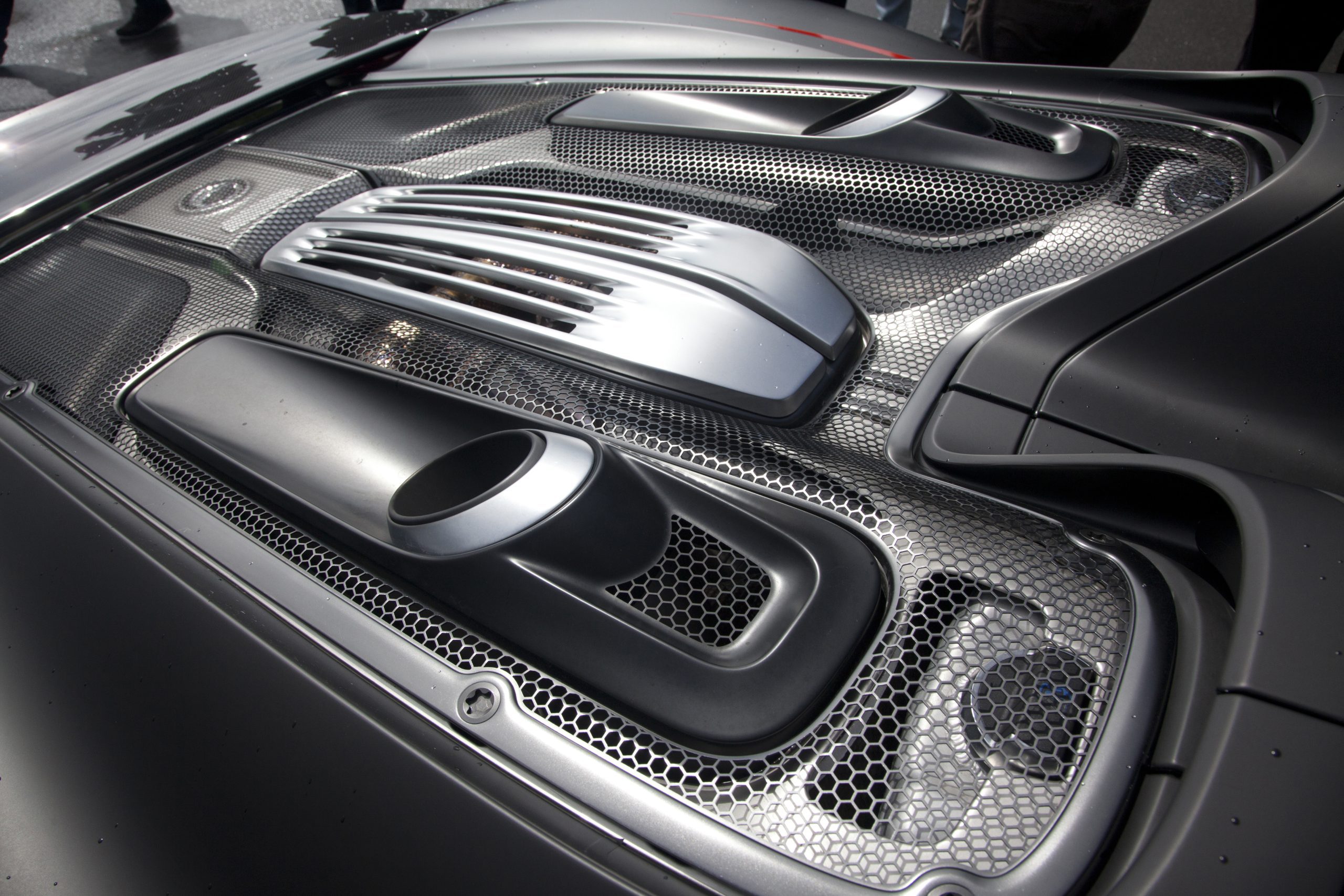
Performance
As you'd expect for a top-of-the-range Porsche, the 918 Spyder's performance is simply blistering. This car is far from all show and no go.
Power comes from a mid-mounted, racecar-derived 4.6-litre, 608hp V8 teamed with two electric motors, with the rear producing the equivalent of 154hp and the front – driving just the front wheels up to 146mph – producing 127hp.
The combined output of the system is somewhere in the region of 887hp.
A seven-speed PDK gearbox drives power to the rear wheels, meaning high-speed drifting is very possible.
0-62 comes up in around 2.8 seconds, with a top speed somewhere north of 211mph.
Being a plug-in hybrid, the 918 Spyder can do all this and run silently in electric-only mode for a quoted range of 18 miles.
Ride & Handling
Ride in any high performance car is a relative thing, and compared with its peers the 918 Spyder returns a comfortable driving experience.
Four-wheel drive, torque vectoring and rear-wheel steering help out in the twisty stuff too, while a multilink rear axle with adaptive electro-mechanical settings allows the car to be set up to the driver's tastes.
Porsche Active Suspension Management (PASM) allows each corner to talk to the rest of the car, optimising damping for the driving and road conditions.
Even with its electro-mechanical steering setup, reviews of the 918 Spyder suggest it handles as good as the best from Porsche's past. It's as precise as you'd expect a Porsche hypercar to be.
Compared with the lunatic V10 Carrera GT, you could even describe it as civilised.
Prices & Specs
Starting prices for the Porsche 918 were, comparitively for a hypercar from a major manufacturer, cheap.
Entry to the brand-new 918 club started at €781,155, rising to €853,155 for Weissach package cars – for those seeking even greater performance that could do without some of the creature comforts, including comfy seats, sound deadening and about €72,000.
Weissach cars also get extra-lightweight magnesium wheels, reducing the unsprung weight of the car.
Porsche 918 Spyder Specs & Performance Numbers
It's impossible to describe the Porsche 918 Spyder's performance figures without resorting to hyperbole. The all-out go of this machine is absolutely astounding.
Surprisingly for a God-tier hypercar however, the 918 Spyder's green credentials (on paper at least) are very good too. Take a gander at the table below and see what we mean.
The 918 Spyder launched alongside hybrid hypercar rivals from Ferrari and McLaren, ushering in a new era of all-out performance borne out of the combination of two power sources. Sure, better fuel economy may just be a byproduct of the pursuit of speed, but it is also a stepping stone to zero emissions machines utilising progressive powertrains that return the thrills without pouring tonnes of harmful gases into the atmosphere.
Cast your eyes at the numbers and stats below to get in-depth with the Porsche 918 Spyder.
Model & Price Info
| Model & Price Info | |
| Make | Porsche |
| Model | 918 Spyder |
| Generation | 2013-2015 |
| Sub-Model | Weissach package |
| Car type | Super Sports Car |
| Category | Series Production Car |
| Built At | Stuttgart, Germany |
| Released at | Frankfurt Motor Show 2013 |
| Introduced | Jun-13 |
| Base Price (US) | $845,000 (for Weissach cars add $84,000) |
| Base Price (Europe) | €611,000 / £511,00 |
| Units build | 918 units |
Body, suspension & powertrain
| Body, suspension & powertrain | |
| Curb Weight | 1640kg (3615lb) |
| Layout | mid-engine, four-wheel-drive |
| Body / Frame | carbon fibre reinforced plastics (CFRP) monocoque interlocked with CFRP unit carrier; two-piece Targa roof; fixed roll-over protection system |
| Driven wheels | 4WD |
| F suspension | double wishbones, optional electro-pneumatic lift system on front axle |
| R suspension | multi-link with adaptive electro-mechanical system and rear wheel steering |
| Engine | Parallel full hybrid; 4.6-litre V8 with dry-sump lubrication, hybrid module with electric motor and decoupler; electric motor with decoupler and gear unit on front axle; auto start/stop function; electrical system recuperation; four cooling circuits for motors, transmission and battery; thermal management |
| Position | mid-mounted |
| Aspiration | naturally aspirated |
| Block Material | aluminium |
| Valvetrain | DOHC, 4 valves per cylinder |
| Fuel Feed | direct fuel injection |
| Displacement (Liters) | 4.8 litres |
| Displacement (in³) | 280.285 in³ |
| Transmission | 7-speed PDK automatic |
Engine & Output
| Engine & output | |
| Power (kW) | 661kW @ 8600rpm |
| Power (bhp) | 887 hp @ 8600rpm |
| Power (kw) / liter | 133 hp |
| Power (bhp) / liter | 99kW |
| Power (kw) / weight | 389kW / ton |
| Power (bhp) / weight | 521.76 hp / ton |
| Torque | 940 lb-ft |
| Efficiency | 3.3l / 100km |
| Specific output | |
| Average fuel consumption |
Performance & Acceleration stats
| Performance & Acceleration | |
| Top speed | 211 mph+ |
| 0 – 100 kph | 2.5 s |
| 0 – 120 km/h | |
| 0 – 140 km/h | |
| 0 – 160 km/h | 4.9 s |
| 0 – 180 km/h | 5.9 s |
| 0 – 200 km/h | 7 s |
| 0 – 60 mph | 2.2 s |
| 0 – 100 mph | 4.9 s |
| 1/8 mile | 6.4 s @ 118mph |
| 1/4 mile | 9.8 s @145mph |
| 1000 m | 17.7 s @ 184mph |
| Lateral acceleration | 1.12 g |
| Nürburgring Lap Time | 6:57 |
Image Galleries & Videos
Photos & Wallpapers
Catch the Porsche 918 Spyder from just about any angle and it is hard to spot a detail that hasn't been breathed on by Porsche's engineers.
From the vertical-exit tailpipes and the Spyder removable roof, to the carbon fibre tub designed to accommodate the plug-in hybrid's hefty battery packs and PDK transmission as low as possible, everything about the 918 Spyder has been designed with absolute peak performance in mind.
That makes it all the more impressive that inside the Porsche comes with all the creature comforts you'd expect in the 21st century; modern infotainment system, multi-function steering wheel, climate control and a high-end Burmester sound system all add to the expierience, without detracting from the driver-focused cockpit, designed to perfectly suit the needs of a driver chasing their next personal best lap time.
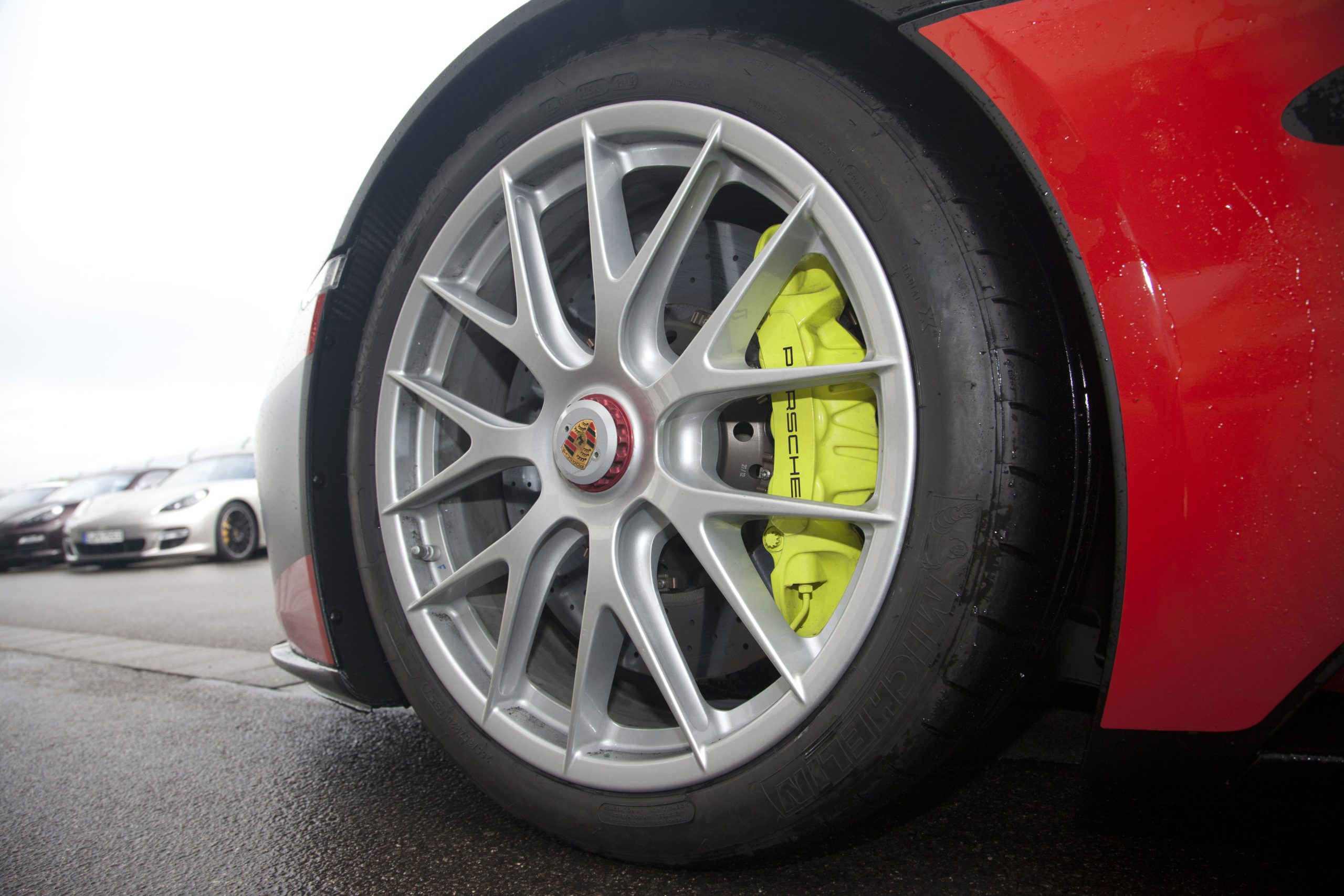
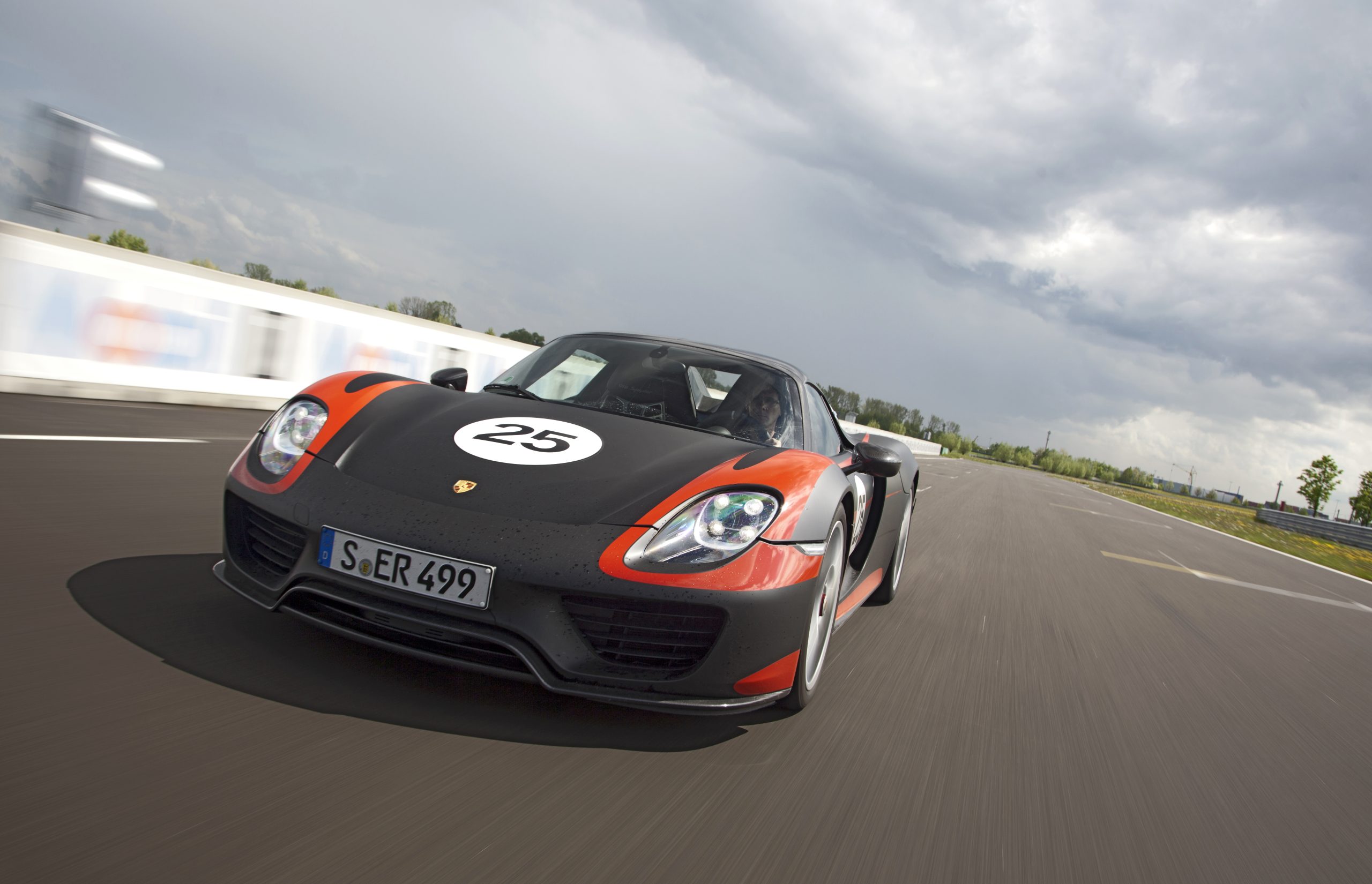
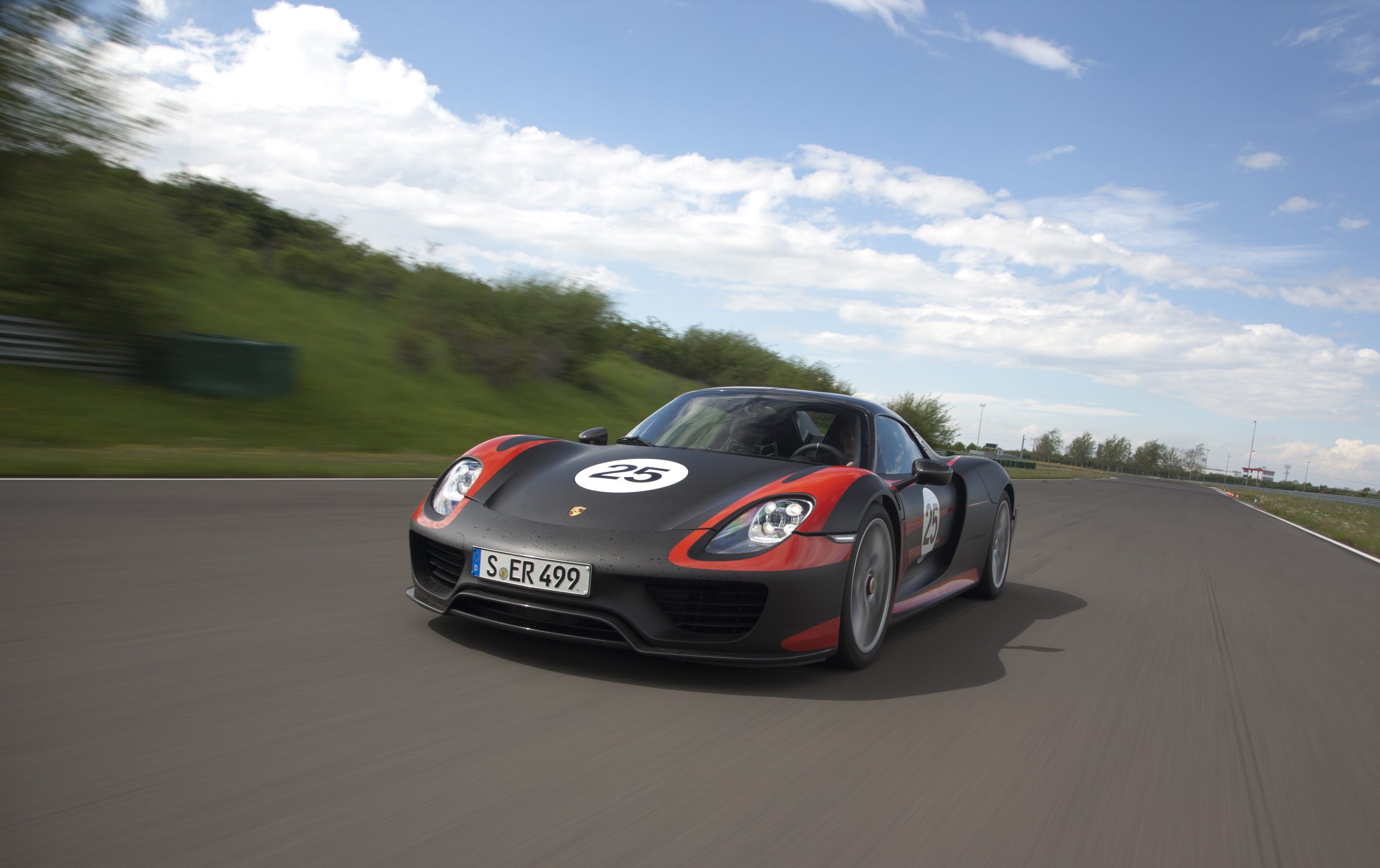
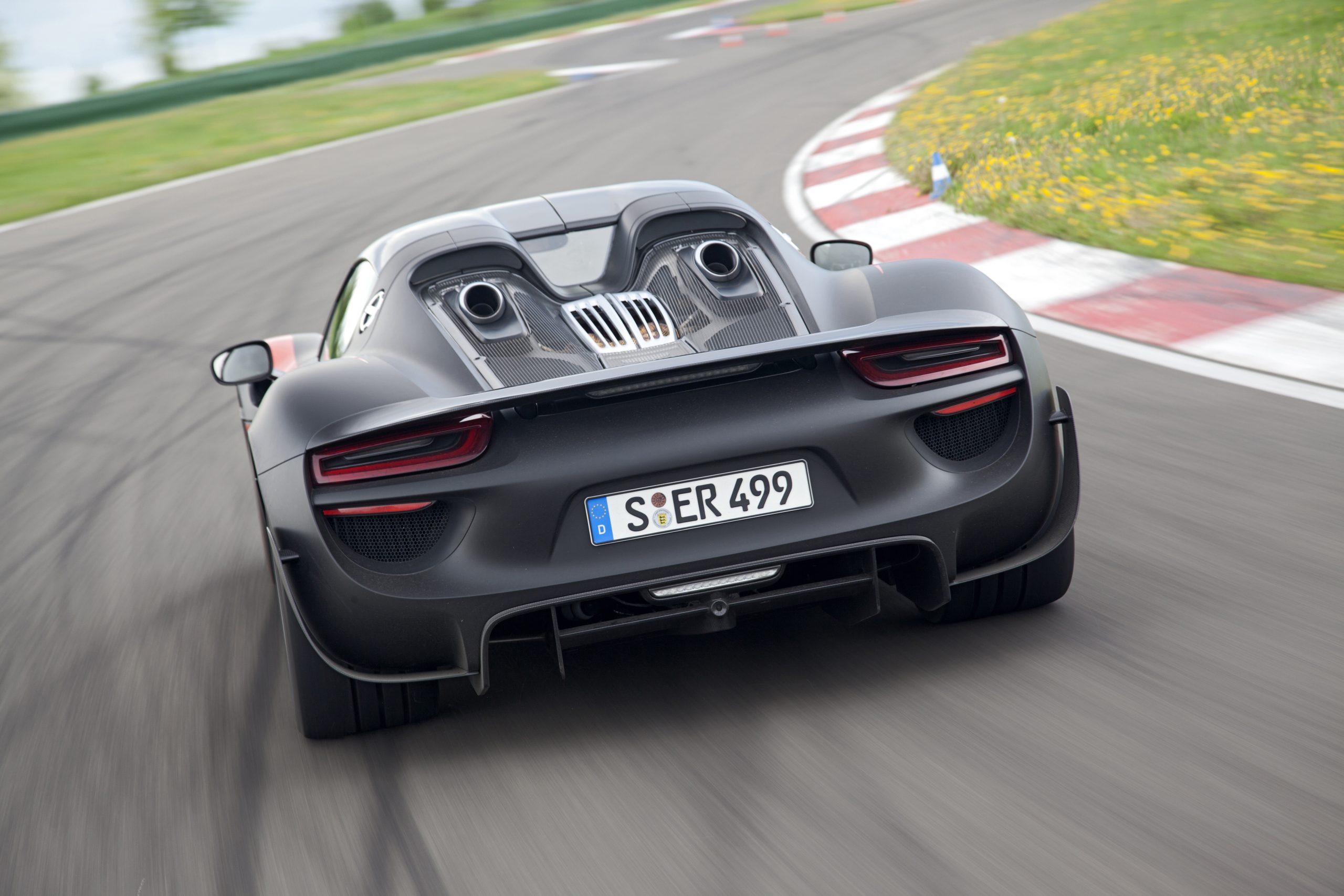
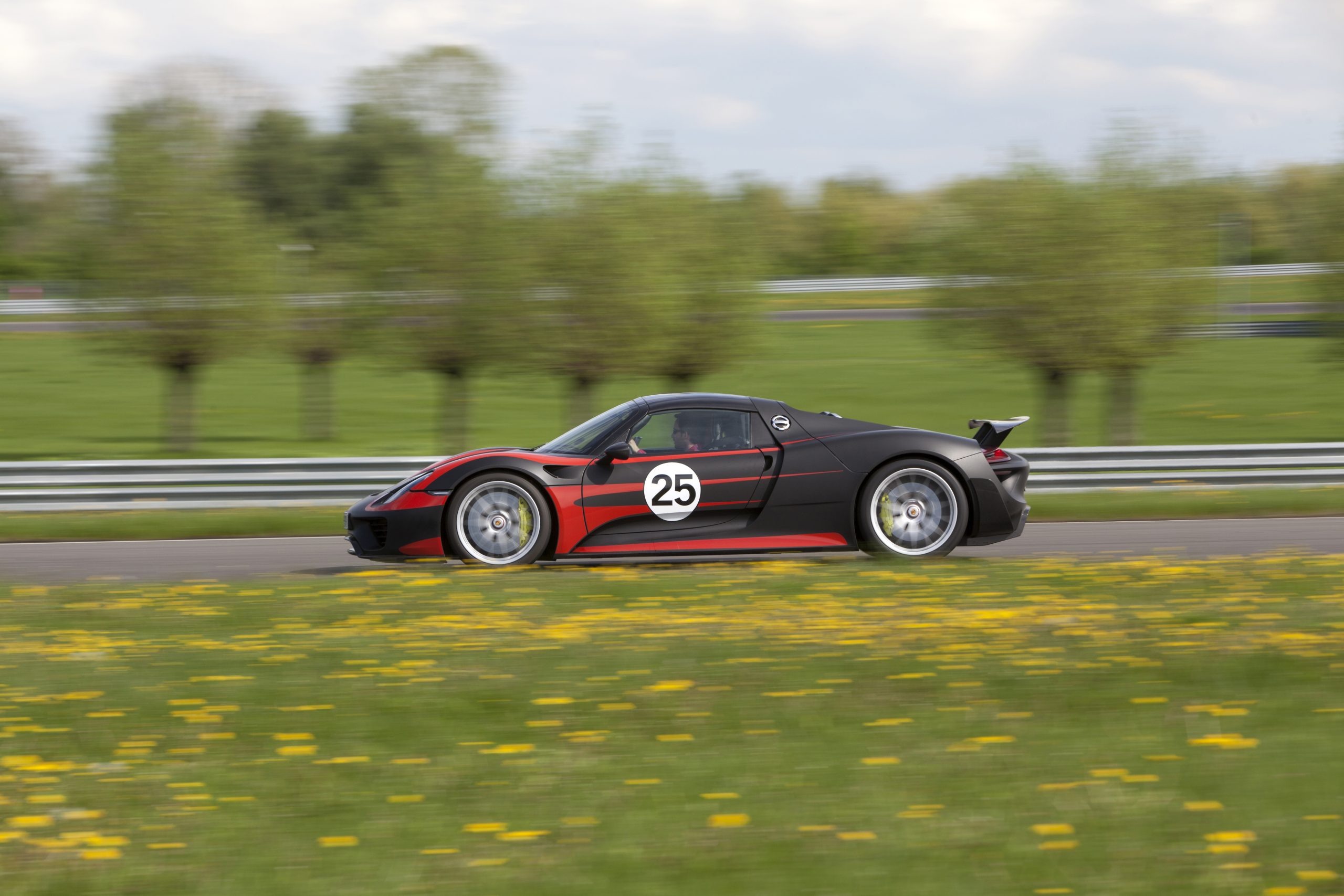

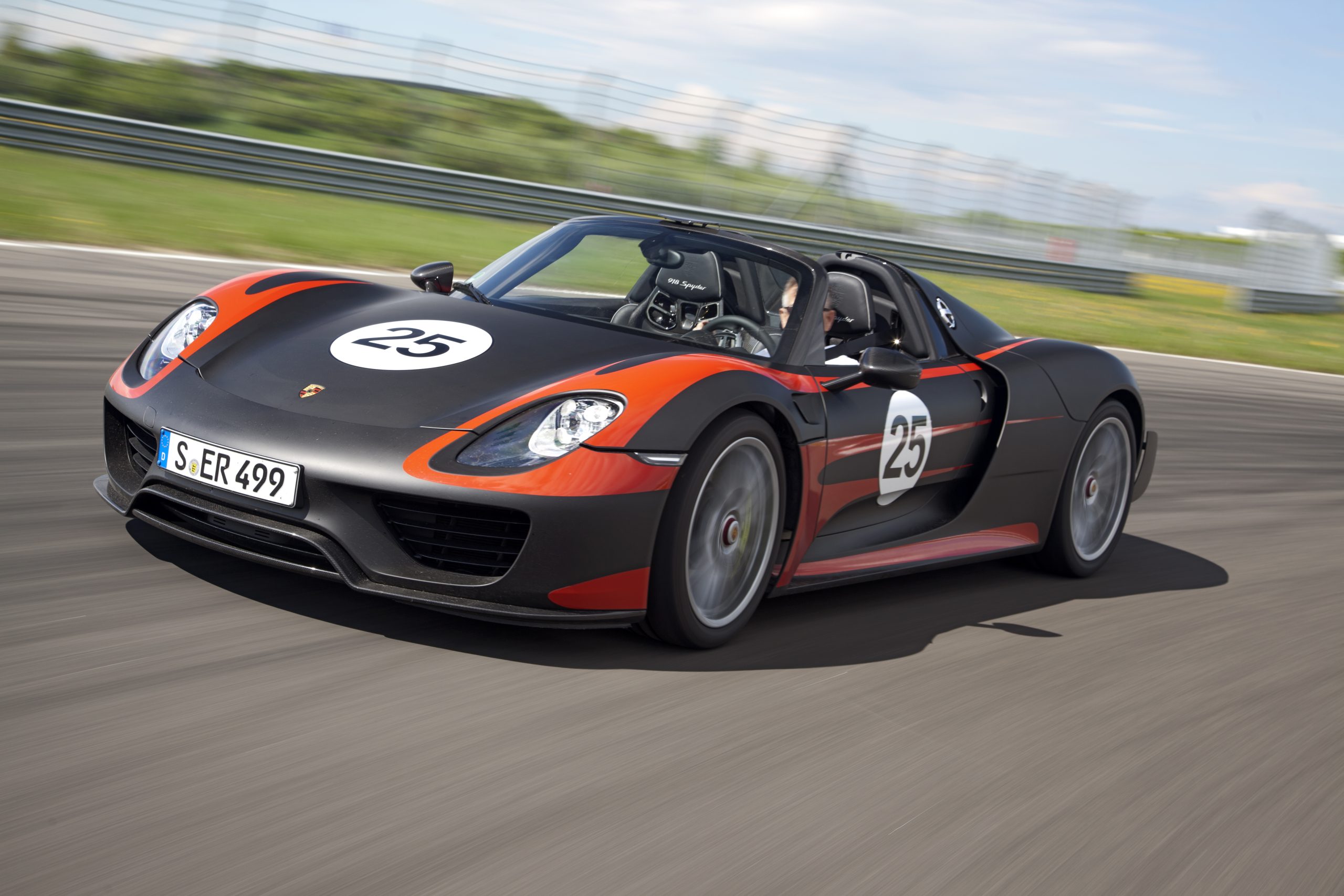
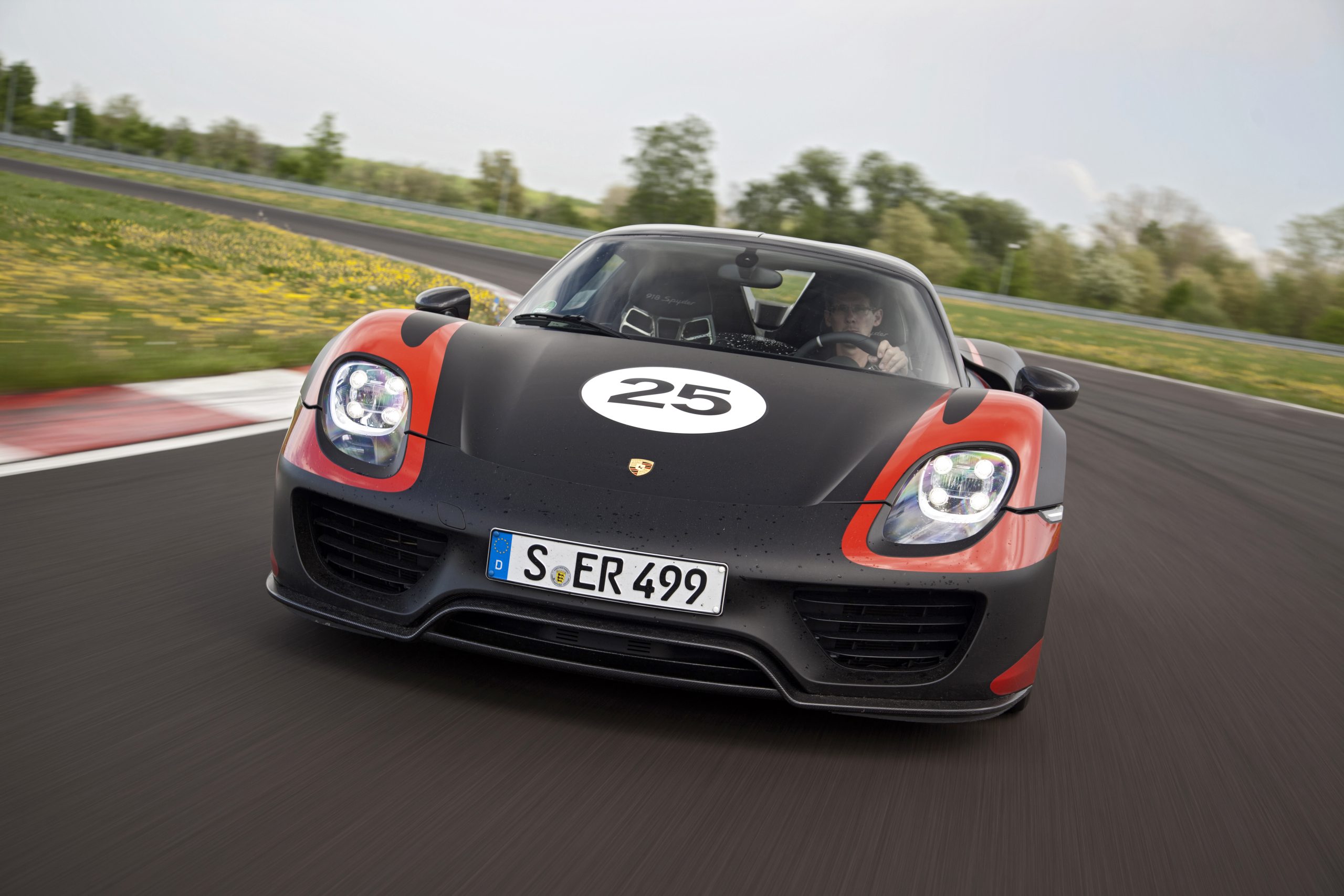



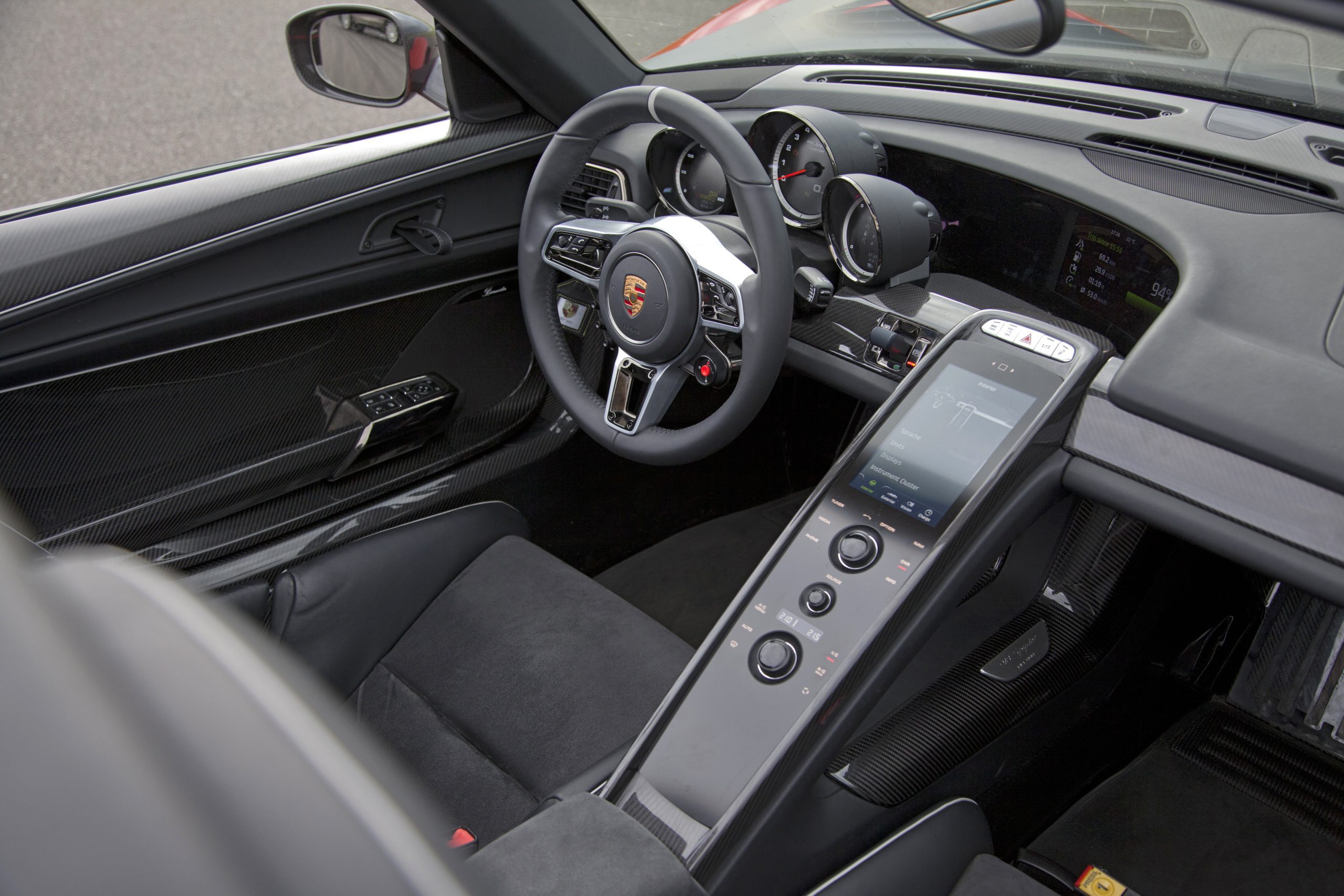
Porsche 918 Spyder Videos
We've scoured the corners of the Internet to bring you the highlights of the wealth of Porsche 918 Spyder content out there, curated from some of our favourite automotive journalists, experts and opinion shapers lucky enough to take a spin behind the wheel of hypercar royalty such as this.
So what are you waiting for? Sit back, get comfortable, and feast your hypercar-seeking soul on these 918 Spyder films.
Steve Sutcliffe heads to test the Porsche 918 Spyder for Autocar cites earlier doubts from a 2011 edition of the magazine that there could be a time where any car could surpass the Bugatti Veyron Supersports. Rather excitingly, he feels that time had already come by 2013, when he got his first experience of the Porsche 918.
Pitting any car against something so world-beating as a Bugatti Veyron is always going to be a daunting undertaking, but given the level at which the 918 Spyder is playing – in terms of technology and all-out pace and performance – we think it's in with a shot. Don't forget that Porsche's owners, Volkswagen, also signed off on the Veyron project, and the Chiron that followed it.
Perhaps most illustrative of the 918's capabilities is the segment of the video where Steve keeps pace with Walter Rohrl – who himself is pushing hard in an Porsche 911 Turbo!
Doug DeMuro has been very kindly loaned a stunning grey-with-red-highlights example of the Porsche 918 Spyder by an Instagrammer with excellent taste and enough money for such things. (An increasingly rare combination these days…)
Over the course of almost 30 minutes, Doug pores over the details of the 918, even giving a point-of-view button-pressing overview of the steering wheel. And we're so glad he did, because the level of attention to detail in the 918 is extraordinary… as you might expect from a halo Porsche.
Access all areas of this Porsche legend without leaving your living room chair. Geeks welcome.
Filming the 918 on a deserted Abu Dhabi GP circuit for old Top Gear, this video featuring Richard 'Hamster' Hammond is worth a watch for the cinematic detail alone.
It's night, and the hamster has free reign over the track. The 918 takes centre stage however (how could it not?!), spitting fire from those top-exit exhaust pipes, barking and snapping and snarling its way around the Yas Marina.
Pitting the 918 Spyder against one of its most formidable contemporary rivals around Anglesey Circuit, UK, Jethro Bovingdon for EVO has his hands full.
With Jethro driving the P1 first, we get to see just what the 918 is up against – the McLaren flexes and exhales, demonstrating that it isn't to be messed with. How does the Porsche shape up against it? Watch below and find out…
Mike Spinelli wrestles with the sheer conceptual greatness of the Porsche 918 Spyder before letting Porsche factory driver Patrick Long put it through his paces a Circuit of the Americas.
While Mike himself doesn't get behind the wheel, there is some truly stunning footage of the car scithing across the vast tarmac of the Texan circuit, dubbed over with Spinelli's enthusiastic and expert comment.
In this video for The Drive, Chris Harris traces the three-and-a-half year journey to the birth of the 918 Spyder, tackling the addition of the hybrid system head on and considering the build-up to the launch of the 918 in the context of its arrival – and what it has to prove to the world.
After rifling through the car's stats (set to some fabulous slow-mo footage of him drifting the car through the curves of the Valencia Circuit), Harris hops behind the wheel.
Original Press Release
Introducing the Porsche 918 Spyder
A unique combination of performance and efficiency
May 16, 2013 | Atlanta. The 918 Spyder embodies the essence of the Porsche idea: it combines pedigree motor racing technology with excellent everyday utility, and maximum performance with minimum consumption. The task faced by the development team was to create the super sports car for the next decade with a highly efficient and powerful hybrid drive. Developing the car from scratch, appropriately beginning with a sheet of white paper, allowed the team to come up with a no-compromise concept. The entire car was designed around the hybrid drive. The 918 Spyder therefore demonstrates the potential of the hybrid drive to a degree never seen before: the parallel improvement of both efficiency and performance without one being at the cost of the other. This is the idea that has made the Porsche 911 the most successful sports car in the world for 50 years. In short, the 918 Spyder will act as the gene pool for the Porsche sports cars of the future.
The 918 Spyder reveals its close links to motorsport in a variety of ways. It has been designed, developed and produced by Porsche engineers who build race cars, in cooperation with series production specialists. A great deal of insight gained from the development of Porsche race cars for the 24 hours race in Le Mans in 2014 is thus integrated into the 918 Spyder – and vice versa. The structural concept of the 918 Spyder with a rolling chassis as its basis – a basic vehicle that can be driven even without a body – is race car tradition at Porsche. The concept of the V8 engine originates from the LMP2 RS Spyder race car. The load-bearing structures, the monocoque and subframe, are made of carbon fiber reinforced polymer. Porsche has many years of experience with this high-strength, lightweight construction material and has again achieved top results with the development of the series production 918 Spyder. Many parts of the super sports car come from manufacturers who have a proven record as suppliers for motorsport vehicles.
Hybrid drive brings advantages in terms of driving dynamics
A key message of the 918 Spyder is that the hybrid drive from Porsche is a plus for no-compromise driving dynamics. Drivers can experience this thanks to the unique all-wheel drive concept with a combination of combustion engine and electric motor on the rear axle and the second electric motor on the front axle. It is based on knowledge gained by Porsche during motor races with the successful 911 GT3 R Hybrid. Due to the additional, individually controllable front drive, new driving strategies for extremely high, safe cornering speeds can be implemented, especially for bends. Furthermore, the advanced "boost" strategy manages the energy of the electric drive so intelligently that, for every sprint with maximum acceleration, the full power of the 918 Spyder can be tapped into by simply pressing the accelerator down fully. In short, the 918 Spyder allows even drivers without motorsport training to experience the potential of advanced longitudinal and transverse dynamics.
The Porsche 918 Spyder also has the potential to break many records. The current lap time for the North Loop of the Nürburgring is 7:14 minutes. This time was achieved in the presence of international journalists during test drives in September 2012 – more than a year before start of production. The 918 Spyder prototype was therefore approximately 20 seconds quicker than the Porsche Carrera GT. More test drives on the Nürburgring North Loop will follow. An even more important factor is that the 918 Spyder surpasses previous models and competitors by far in its efficiency as well. As a plug-in hybrid vehicle, it systematically combines the dynamic performance of a racing machine with low fuel consumption. To sum it up: maximum driving fun with minimal fuel consumption.
Carbon monocoque guarantees lightweight design with a low center of gravity
The 918 Spyder utilizes the best state-of-the-art technologies, taken straight from motor racing, to achieve its top performance. The entire load-bearing structure is made of carbon fiber reinforced polymer (CFRP) for extreme torsional rigidity. Additional crash elements at the front and rear absorb and reduce the energy of a collision. The car's unladen weight of approximately 3,715 lbs. (3,616 lbs. with "Weissach" package), an excellent low weight for a hybrid vehicle of this performance class, is largely attributable to this concept.
The drivetrain components and all components weighing over 110 lbs. are located as low and as centrally as possible within the vehicle. This results in a slightly rear end biased axle load distribution of 57 percent on the rear axle and 43 percent on the front axle, combined with an extremely low center of gravity at approximately the height of the wheel hubs, which is ideal for driving dynamics. The central and low position of the traction battery directly behind the driver not only supports efforts to concentrate masses and lower the center of gravity; it also provides the best temperature conditions for optimum battery power capacity.
Chassis with race car genes and rear-axle steering
The multi-link chassis of the Porsche 918 Spyder is inspired by motorsport design, complemented by additional systems such as the PASM adaptive shock-absorber system and rear-axle steering. Basically, this incorporates an electro-mechanical adjustment system at each rear wheel. The adjustment is speed-sensitive and executes steering angles of up to three degrees in each direction. The rear axle can therefore be steered in the same direction as the front wheels or in opposition to them. At low speeds, the system steers the rear wheels in a direction opposite to that of the front wheels. This makes cornering even more direct, faster and more precise, and it reduces the turning circle. At higher speeds, the system steers the rear wheels in the same direction as the front wheels. This significantly improves the stability of the rear end when changing lanes quickly. The result is very secure and stable handling.
Porsche Active Aerodynamic (PAA) for different driving modes
Porsche Active Aerodynamic (PAA), a system of adjustable aerodynamic elements, ensures unique and variable aerodynamics; its layout is automatically varied over three modes ranging from optimal efficiency to maximum downforce and is tuned to the operating modes of the hybrid drive system. In "Race" mode, the retractable rear wing is set to a steep angle to generate high downforce at the rear axle. The spoiler positioned between the two wing supports near the trailing edge of the airflow also extends. In addition, two adjustable air flaps are opened in the underfloor in front of the front axle, and they direct a portion of the air into the diffuser channels of the underbody structure. This also produces a "ground effect" at the front axle.
In "Sport" mode, the aerodynamic control system reduces the attack angle of the rear wing somewhat, which enables a higher top speed. The spoiler remains extended. The aerodynamic flaps in the underfloor area close, which also reduces aerodynamic drag and increases attainable vehicle speeds. In "E" mode, the control is configured entirely for low aerodynamic drag; the rear wing and spoiler are retracted and the underfloor flaps are closed.
Adjustable air inlets under the main headlights round off the adaptive aerodynamic system. When the vehicle is stationary and in "Race" and "Sport" mode, they are opened for maximum cooling air intake. In "E-Power" and "Hybrid" modes, they close immediately after the car is driven off in order to keep aerodynamic drag to a minimum. They are not opened until the car reaches speeds of approximately 81 mph or when cooling requirements are higher.
From comfortable to race-ready: five modes for three motors
The core of the 918 Spyder concept is its distribution of propulsive power among the three power units; their cooperation is controlled by an intelligent management system. To best exploit these different approaches, the Porsche developers defined five operating modes that can be activated via a "map switch" on the steering wheel, just like in motorsport cars. On the basis of this pre-selection, the 918 Spyder applies the most suitable operating and boost strategy without driver intervention, thus allowing the driver to concentrate fully on the road.
Quiet and elegant: "E-Power"
When the vehicle is started up, the "E-Power" mode is the default operating mode as long as the battery is sufficiently charged. In ideal conditions, the 918 Spyder can cover approximately 18 miles on purely electric power. Even in pure electric mode, the 918 Spyder accelerates from 0 to 62 mph in seven seconds and can reach speeds of up to 93 mph. In this mode, the combustion engine is only used when needed. If the battery's charge state drops below a set minimum value, the vehicle automatically switches to hybrid mode.
Efficient and comfortable: "Hybrid"
In "Hybrid" mode, the electric motors and combustion engine work alternately with a focus on maximum efficiency and minimum fuel consumption. The use of individual drive components is modified as a function of the current driving situation and the desired performance. The Hybrid mode is typically used for a fuel economy-oriented driving style.
Sporty and dynamic: "Sport Hybrid"
In more dynamic situations, the 918 Spyder selects the "Sport Hybrid" mode for its power sources. The combustion engine now operates continuously and provides the main propulsive force. In addition, the electric motors provide support in the form of electric boosting or when the operating point of the combustion engine can be optimized for greater efficiency. The focus of this mode is on performance and a sporty driving style at top speed.
For fast laps: "Race Hybrid"
"Race Hybrid" is the mode for maximum performance and an especially sporty driving style. The combustion engine is chiefly used under high load, and charges the battery when the driver is not utilizing its maximum output. Again, the electric motors provide additional support in the form of boosting. Furthermore, the gear-shifting program of the PDK is set up for even sportier driving. The electric motors are used up to the maximum power output limit to deliver the best possible performance for the race track. In this mode, the battery charge state is not kept constant, rather it fluctuates over the entire charge range. In contrast to Sport Hybrid mode, the electric motors run at their maximum power output limit for a short time for better boosting. This increased output is balanced by the combustion engine charging the battery more intensively. Electric power is thus available even with several very fast laps.
For pole position: "Hot Lap"
The "Hot Lap" button in the middle of the map switch releases the final reserves of the 918 Spyder and can only be activated in "Race Hybrid" mode. Similar to a qualification mode, this pushes the traction battery to its maximum power output limits for a few fast laps. This mode uses all of the available energy in the battery.
Main propulsion: the race car's eight cylinder engine
The main source of propulsion is the 4.6-liter, eight cylinder engine that produces 608 hp of power. The engine is derived directly from the power unit of the successful RS Spyder, which explains why it can deliver engine speeds of up to 9,150 rpm. Like the race engine of the RS Spyder, the 918 Spyder power unit features dry-sump lubrication with a separate oil tank and oil extraction. To save weight, components such as the oil tank, the air filter box integrated into the subframe and the air induction are made of carbon fiber reinforced polymer. Further extensive lightweight design measures have resulted in such features as titanium connecting rods, thin-wall, low-pressure casting on the crank case and the cylinder heads, a high-strength, lightweight steel crankshaft with 180 degrees crankpin offset and the extremely thin-walled alloy steel/nickel exhaust system. Striking features of the V8 are that it no longer supports any auxiliary systems, there are no external belt drives and the engine is therefore particularly compact. Weight and performance optimizations achieve a power output per liter of approx. 133 hp/l – the highest power output per liter of a Porsche naturally aspirated engine – which is significantly higher than that of the Carrera GT (106 hp/l) and outstanding for a naturally aspirated engine.
Unique race car design heritage: top pipes
It isn't just this engine's performance but also the sound it makes that stokes the emotionality of the 918 Spyder. This is attributable first and foremost to the so-called top pipes: the tailpipes terminate in the upper part of the rear end immediately above the engine. No other production vehicle uses this solution. The top pipes' greatest benefit is optimal heat removal, because the hot exhaust gases are released via the shortest possible route, and exhaust gas back pressure remains low. This design requires a new thermodynamic air channeling concept. With the HSI engine, the hot side is located inside the cylinder V, the intake channels are on the outside. There is another benefit as well: the engine compartment remains cooler. This is especially beneficial to the lithium-ion traction battery, as it provides optimum performance at temperatures between 68 and 104 degrees Fahrenheit. Consequently, less energy needs to be used for active cooling of the battery.
In parallel in the drivetrain: hybrid module
The V8 engine is coupled to the hybrid module, since the 918 Spyder is designed as a parallel hybrid like the current hybrid models from Porsche. Essentially, the hybrid module comprises a 115 kW electric motor and a decoupler that serves as the connection with the combustion engine. Because of its parallel hybrid configuration, the 918 Spyder can be powered at the rear axle either individually by the combustion engine or electric motor or via both drives jointly. As is typical for a Porsche super sports car, the power pack in the 918 Spyder has been placed in front of the rear axle, and does not have any direct mechanical connection to the front axle.
Upside-down for a low center of gravity: Doppelkupplung
A seven-speed Doppelkupplung (PDK) transmission handles power transmission to the rear axle. The high-performance transmission is the sportiest version of the successful PDK; it has undergone a complete redesign for the 918 Spyder and has been further optimized for high performance. To ensure a low mounting position for a low center of gravity of the entire vehicle, the gear unit was turned "upside down" by rotating it 180 degrees about its longitudinal axis, in contrast to other Porsche series. If no power is required on the rear axle, the two motors can be decoupled by opening the decoupler and PDK clutches. This is the action behind the Porsche hybrid drive's typical "coasting" with the combustion engine switched off.
Independent all-wheel drive: front axle with electric motor
On the front axle, there is another independent electric motor with an output of approximately 95 kW. The front electric drive unit drives the wheels at a fixed ratio. A decoupler decouples the electric motor at high speeds to prevent the motor from over-revving. Drive torque is independently controlled for each axle. This makes for very responsive all-wheel drive functionality that offers great potential in terms of traction and driving dynamics.
Lithium-ion battery with plug-in charging system
The electric energy for the electric motors is stored by a liquid-cooled lithium-ion battery comprising 312 individual cells with an energy content of about seven kilowatt hours. The battery of the 918 Spyder has a performance-oriented design in terms of both power charging and output, so that it can fulfill the performance requirements of the electric motor. The power capacity and the operating life of the lithium-ion traction battery depend on several factors, including thermal conditions. That is why the battery of the 918 Spyder is liquid-cooled by a dedicated cooling circuit. The global warranty period for the traction battery is seven years.
To supply it with energy, Porsche developed a new system with a plug-in vehicle charge port and improved recuperation potential. This vehicle charge port in the B-pillar on the front passenger side lets users connect the storage battery to an electrical supply at home to charge it. The charge port is standardized for the country of purchase. The on-board charger is located close to the traction battery. It converts the alternating current of the household electric supply into direct current with a maximum charge output of 3.6 kW. Using the supplied Porsche Universal Charger (AC), the traction battery can be charged with a conventional wall plug in seven hours from a ten ampere rated, fused power socket a US 110 Volt household electrical supply, for example. Furthermore, the Porsche Universal Charger (AC) can be installed at home in the garage using the Charging Dock. It enables rapid and convenient charging within approximately two hours, irrespective of regional conditions. The Porsche Speed Charging Station (DC) is available as an optional extra. It can fully charge the high-voltage battery of the 918 Spyder in just 25 minutes.
Pioneering control concept: clear organization of the cockpit
The driver is the focus of all technology in the future Porsche super sports car. A cockpit was created for the driver that is typical of the brand and pioneering in its clarity. It is partitioned into two basic areas. First, there are the controls that are important for driving, which are grouped around the multifunction steering wheel, combined with driver information displayed on three large round instruments. Second, there is the infotainment block that is housed in the lifted center console, which was introduced in the Carrera GT. Control functions, e.g. for the automatic climate control system, wing adjustment, lighting and Porsche Communication Management (PCM), including a Burmester high-end sound system, can be intuitively operated by multitouch with a new type of black panel technology.
For even higher performance: the Weissach package
For very performance-oriented customers of the 918 Spyder, Porsche offers the "Weissach" package. These modified super sports cars can be recognized at first glance by special colors and designs that are based on legendary Porsche race cars. The roof, rear wings, rear-view mirrors and frames of the windscreen are made of visible carbon. Parts of the interior are upholstered with Alcantara instead of leather, and visible carbon replaces much of the aluminum. Sound insulation has been reduced. The emphasis on performance is not just visual: very lightweight magnesium wheels reduce unsprung masses; gross weight was reduced by about 77 lbs. The benefits are experienced in further improved dynamic performance. Other references from motorsport are six-point seatbelts for driver and front passenger, optional film-coating instead of body paint, as well as additional aerodynamic body parts in visible carbon.
Porsche redefined: a new super sports car for a new decade
The 918 Spyder continues a long tradition of super sports cars at Porsche; as technology platforms, as the driving force behind both car emotion and car evolution and as the ultimate sports cars of their decades: the Carrera GTS, the first Porsche Turbo, the 959, the 911 GT1, the Carrera GT. More than any of its predecessors, the 918 Spyder is providing key impetus for developing technologies for future vehicle concepts. It offers a complete package of components that reflect Porsche DNA – more concentrated than ever before.
The Verdict Is In
What The Experts Said…
The world is full of armchair commentators when it comes to cars. At Supercars.net, we have a number of journalists and automotive publications we rely on when we want to get unbiased opinions from people we admire.
Below, we've outlined some of the things these experts had to say about the Porsche 918 Spyder. We have included snippets only, so definitely dive deeper into their content to find out the details behind their assessments. Please support these awesome publications because they invest a lot in the details, amazing product photographs and great writers.
Autocar – "Be in no doubt: it walks tall, even in the highest of performance leagues…"
First t ogiv their take on the 918 Spyder in our reviews roundup is Autocar. This review kicks off by noting that Porsche have gone for understatement in marketing the 918 Spyder, highlighting that at no point in this car's press material is the word 'hypercar' mentioned – despite the car's obvious capabilities.
The review considers the 918's heritage and rivals, tracing its roots back to the early naughties Carrera GT and, before that, a street-legal 911 GT1, before cross-examining the car in great detail.
Most intriguingly is the piece's way of summing up the 918's split personality; "The 918… probably has more power than a 2015 Honda-engined F1 car… yet emits less CO2 than a Honda Insight economy saloon."
The Good
Incredible performance
Accessibility of full-on track driving speed
Responsiveness
The Bad
Example driven's stickers not to the reviewer's liking
Most testers at Autocar would prefer a P1 on circuit, but that's not to undermine the Porsche's achievement
More: Read the Full Review
__
EVO – "Throttle response and the engine's exploitability help the Porsche stand out.
Henry Catchpole makes no bones about the benchmark for the Porsche 918 Spyder in his review – it's spelled out in the title for one thing that the car this has to beat in his book is the McLaren P1.
The Porsche's mighty torque figure and all-wheel-drive system gives it the edge on traction off the line, allowing it to beat the P1 and LaFerrari off the line on paper. "Porsche is famously conservative with its performance claims, so when it lists a 0-62mph time of 2.6 seconds for the 918 Spyder, it gives you some idea of just how monstrously quick it is…"
The Good
'Blistering performance'
Hybrid technology integrated well
Cheapest to buy of the Holy Trinity
The Bad
Weight and complexity vs rivals
Less visually striking than its rivals, but that could also play in its favour
More: Read the Full Review
__
Wired – "..the Spyder scoots along with the requisite Jetsons-era whooshes and whines…"
Wired's review, penned by Basem Wasef, does a great job of exploring the 918 Spyder's technical achievements, revelling in its comparative understatement from the outside – a rarity at this level – while celebrating its green credentials.
Basem sets off in electric-only mode – with near silent running being one of the more curious side effects in a car of this type of the inclusion of the plug-in hybrid system. All the way, he takes the reader on a journey that builds to the moment he lets rip the 4.6-litre V8 in the car's 'Hot Lap' driving mode in tandem with the e-power. "..the system goes for broke, squeezing the highest possible energy out of the batteries."
The Good
Mind-shifting velocity
Ultra-modern tech used for speed with a conscience
Understated looks – for a hypercar
The Bad
Carbon fibre bucket seats don't recline
Porsche goes wild with the price list on extras
More: Read the Full Review
__
Top Gear – "..fiercely complicated car in the places you can't see, but operating one is bizarrely straightforward…"
This piece by Jack Rix for Top Gear pays tribute to the 918 Spyder long after the launch hype has subsided and all 918 examples have been sold.
He unleashes the 918 Spyder on some back roads in the Scottish highlands with the help of Porsche instructor Matthias Hoffsümmer three years after the car had been launched. Less a critical review and more a tribute piece, this one is worth clicking through for the photography alone, while the words pay meaningful homage to the hybrid hypercar.
The Good
Compliant set up inspires confidence
Aero, suspension and four-wheel drive work in harmony
'Jagged, race-car howl' of the V8 up to 9150rpm
The Bad
All examples sold by this point and used 918s selling for £450,000 more than when new
The jealousy is strong with this piece
More: Read the Full Review
Learn More
Alternatives & Rivals
The Porsche 918 Spyder entered the fray at a time when the competition at the top level of hypercar royalty was about to heat up – with two other hybrid hypercars to contend with. We've included the other members of the 'Holy Trinity' for your consideration, as well as a few other rivals that could be considered worthy of taking on the 918 Spyder.
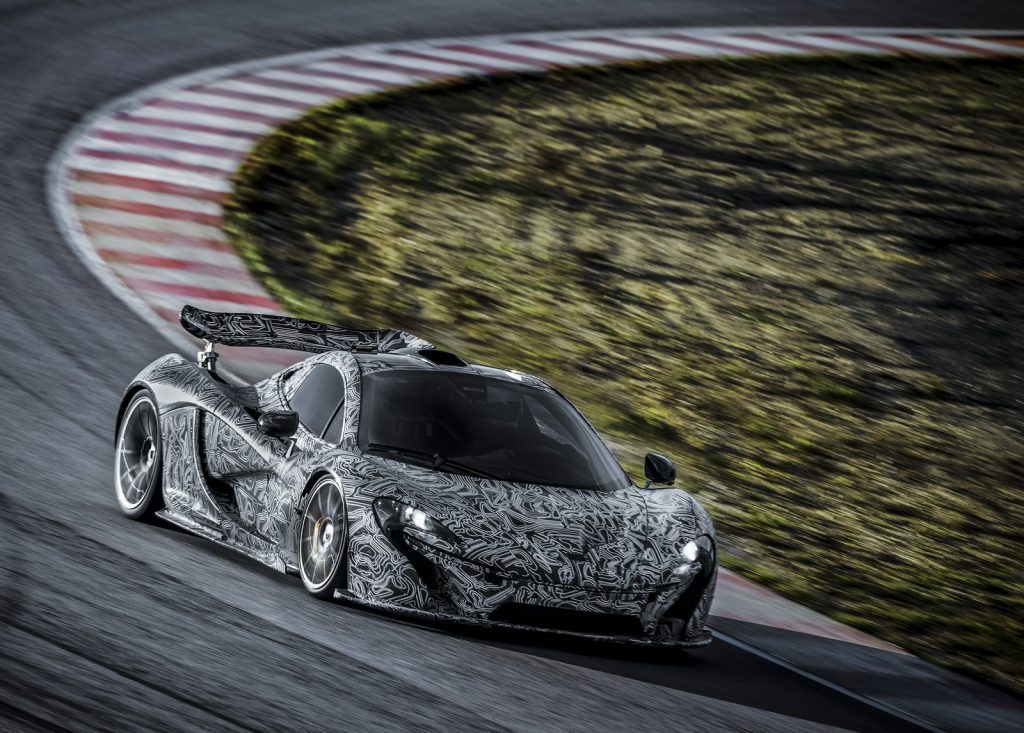
McLaren P1
McLaren's entry to the hybrid hypercar face-off is the P1. Like the Porsche, it is capable of running on electric-only power – boosting its green credentials.
With 727bhp from a turbocharged V8 mated to a 176.6bhp e-motor, that's not all it's boosting. The McLaren is the lightest of the Holy Trinity however, which has compelled many journalists to name it as having the edge out of the three in the corners. Not as accessible as the 918 Spyder, but in the right hands the P1 is an absolute weapon.
Learn More
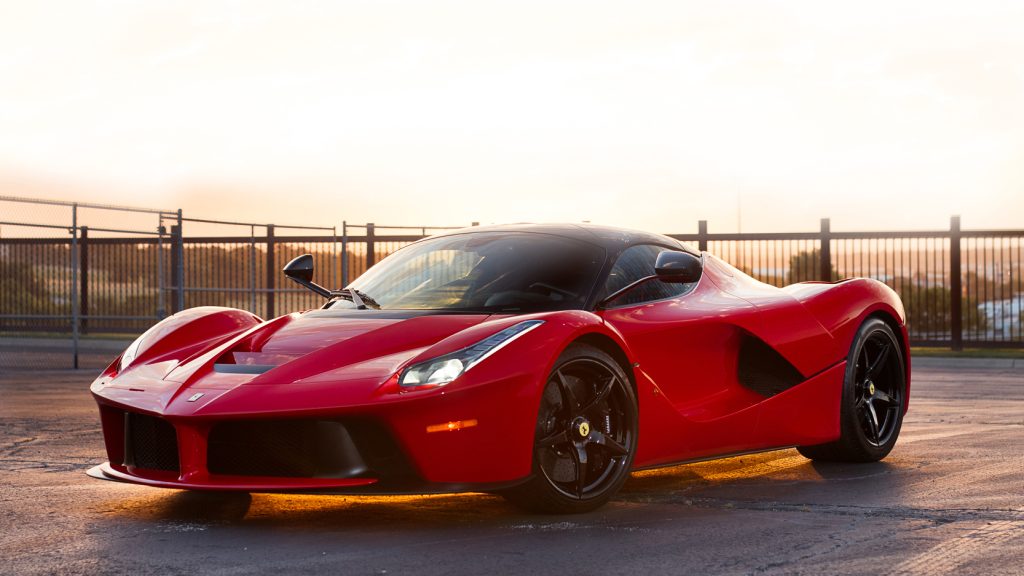
Ferrari LaFerrari
Learn More
Both LaFerrari and the Porsche 918 Spyder are the absolute embodiments of their respective manufacturers' attitude and philosophy towards the super sports car.
LaFerrari is rear-wheel drive, for purity and an edge when it comes to showing off; the 918 Spyder is four-wheel drive, for absolute grip off the line and through the bends. The Porsche's hybrid system has been lauded for bringing mid-size sedan economy to an almost 900hp-output hypercar; Ferrari prides itself in the fact that LaFerrari's hybrid system is present simply in the pursuit of speed and performance.
I guess this one comes down to a matter of personal preference… unless you can afford both, that is.
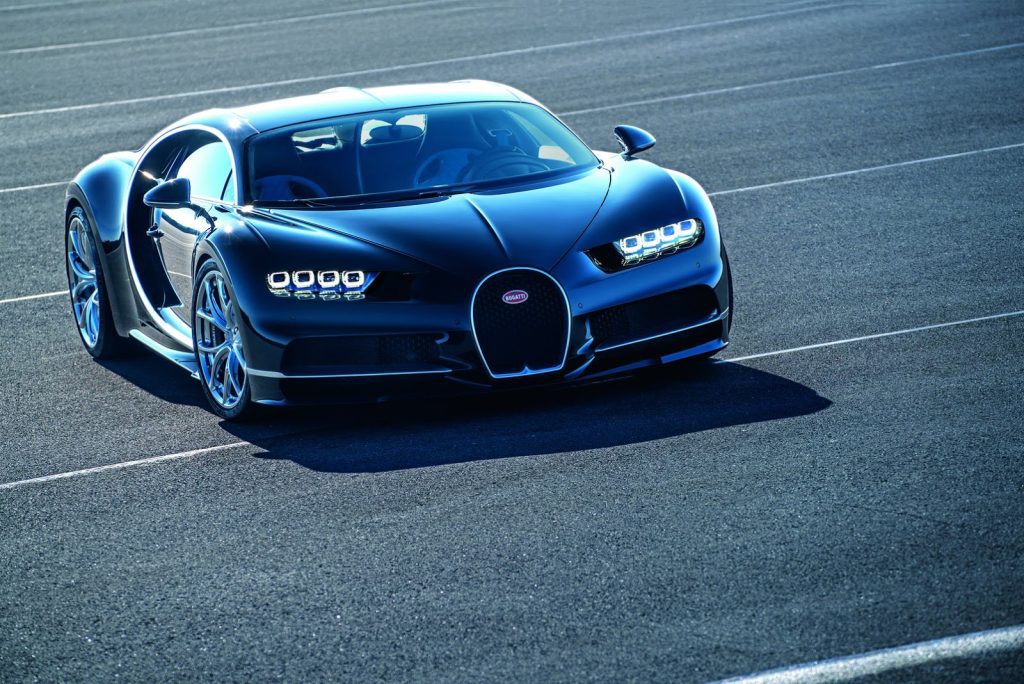
Bugatti Chiron
Arriving shortly after the hypercar triumvirate was the successor to one of the most legendary cars this century. The Bugatti Chiron had big boots to fill after all that the Veyron accomplished, but with this car Bugatti set out to provide a new benchmark, "redefining 'the best'" as the company put it at launch.
You'll find no hybrid system here – instead the Chiron relies on a specially-developed two-stage turbocharging system, with a pair of turbos spinning up from rest, with two more chiming in above 3800rpm.
This results in an output of 1500bhp and 1600nM of torque from 2-6000rpm. Tasty to say the least.
Learn More
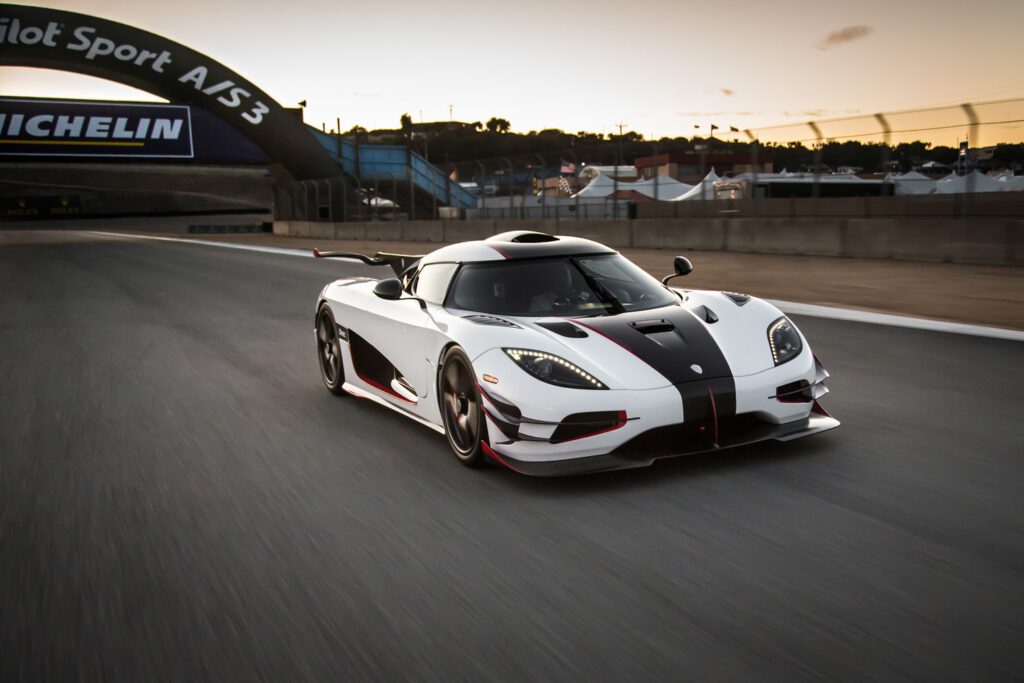
Koenigsegg One:1
The One:1, based on Koenigsegg's Agera platform, is all about the numbers. More scarce than any of the other cars above (only seven plus one prototype were made), with the Swedish hypercar lunatics chasing one ratio: a one-to-one power-to-weight ratio.
Aptly, this 1,360kg machine is fitted with a 1360bhp V8, promising unhinged levels of performance and a sonorous 8250rpm rev limiter to allow full exploration of its ballistic capabilities.
Learn more
Others Rivals: Pagani Huayra, a racecar with indicators stuck on maybe, very little else that is allowed on the road
Our Final Verdict
Setting itself apart from its contemporary rivals by providing the all-out performance along with a raft of creature comforts and the backing of decades of Porsche expertise and experience in refining sports cars, supercars and the odd hypercar, the Porsche 918 Spyder managed to represent relatively good value, undercutting its main rivals at launch by a significant chunk of their asking prices.
Seen as the sensible, silent member of the trio of hypercars for its more muted styling and ability to run in electric-only mode, the 918 Spyder came out to prove it still had a bit of a wild side a la its predecessor, the Carrera GT.
Underneath the crisp business suit exterior, the 918 Spyder is muscular, brash when it wants to be, and capable of all-out fury comparable to the best the world of cars has to offer. What Porsche has done that is so remarkable is made that fury completely accessible to almost anyone sat behind the wheel.
Find A Porsche 918 Spyder for Sale
Considerably more Porsche 918 Spyders were produced than either McLaren P1s or LaFerraris, meaning for the most part auction prices have not crept quite as high on used examples.
That doesn't mean the Porsche wasn't a wise investment at the time; rates have still broken through the $1 million mark, meaning that in many cases the 918 Spyder has added 50% to its monetary worth since launch.
Most sought after are the Weissach package cars; these included extra weight-saving measures and featured magnesium wheels, less sound insulation, and opened up some unique visual options to buyers speccing the package – as well as shaving three seconds off the 'standard' 918 Spyder's time round the Nordschleife.
Despite the Porsche pay-more-get-less philosophy being at play here (Weissach package added $84,000 to the price of the car), around 25% of buyers ticked the box.
James Edition lists at the time of writing six examples of the Porsche 918 Spyder, based in the US, Europe and the UAE, including a rather fetchingly Martini-decalled example, due to go under the hammer at Mecums shortly, and a Dubai-based car that's described as 'brand new'.
A glance at Auto Trader throws up several examples, including this car with striking decals and a price tag that's more than double what the car was offered for from the factory.
Another Martini liveried 918 Spyder, described as unique as the only example to wear the colour Voodoo Blue featured at Barrett Jackson's 2017 Las Vegas auction, sold for $1,760,000.
On duPont Registry, this striking red 918 Spyder with Weissach package caught our attention. Situated in Atlanta, GA, the car has covered just 525 miles from new and is price on request only.
How To Draw A Porsche 918 Spyder
Source: https://www.supercars.net/blog/porsche-918-spyder/
Posted by: hopkinswiturpred.blogspot.com

0 Response to "How To Draw A Porsche 918 Spyder"
Post a Comment